2. State Key Laboratory of Hydraulic Engineering Simulation and Safety, Tianjin University, Tianjin 300072, China
Offshore oil and gas exploration and production has accelerated the development of deepwater platform technology. Spar platforms are widely used in the Gulf of Mexico(GoM)because of their good performance in deepwater conditions. The truss spar is a second-generation spar platform that significantly decreases wave loads on the platform. Heave plates also provide viscous damping and increase the added mass of the platform, thus effectively reducing the heave motion(Dong, 2005).
Investigations of the spar platform’s motion responses have concentrated on the following two aspects: the platform’s heave and pitch motions in the vertical plane and the platform’s vortex-induced motion in the horizontal plane. In this study, we emphasize the platform’s heave-pitch coupling motion. Rho et al.(2002, 2003), Rho and Choi(2004)studied the heave-pitch coupling motion of the spar platform and found that the energy transfer phenomenon between the heave and pitch modes is because of a nonlinear mechanism. Tao et al.(2004)calculated the viscous damping of spar platforms with variable geometries and then incorporated the results into a potential solution. The authors found that the heave-resonant response can be considerably reduced by employing alternative hull shapes to increase damping and change the natural heave period. Hong et al.(2005)studied the Mathieu instability of the spar platform’s pitch that is caused by heave, and also proved that there was a coupling effect between heave and pitch for the spar platform. Neves et al.(2008)employed a coupled non-linear mathematical model to simulate the coupled heave, roll and pitch motions and investigated the dynamic stability of a vertical cylinder in regular waves theoretically and experimentally. Li and Ou(2009)used numerical iteration and viscous damping linearization methods to obtain the heave Response Amplitude Operators(RAOs)of a truss spar with a variable number of heave plates. They also calculated the heave response spectra in the frequency domain and found that the platform’s heave was sensitive to the wave period. Kurian et al.(2009)tested a truss spar’s surge, heave and pitch response in a wave basin and compared the measured data with the results calculated by the MATLAB program named ‘TRSPAR’. Liu et al.(2009)analyzed the conditions for occurrences of Mathieu unstable motion and unstable coupled heave-pitch motions in regular waves to obtain the parameter domain of wave height and the period for unstable motion. Zhao et al.(2009)studied the internal resonance of the spar platform’s heave-pitch coupling motions in regular waves, and the results indicated that the energy of the heave mode was saturated when the wave height arrived at a certain value, and as wave height increased further, the extra energy of the heave mode was transferred to the pitch mode. Shen et al.(2011)studied the heave-pitch coupling motion response of the spar platform by considering 1st-order random wave loads. Montasir and Kurian(2011)used the Morison equation to calculate wave loads and studied the effect of 2nd-order difference frequency forces on the spar platform’s motion responses. The results indicated that the 2nd-order responses were dominant for the spar platform’s surge and pitch. Islam et al.(2012)studied the spar platform’s nonlinear coupled response in severe sea environments using integrated coupled model. Shen et al.(2012)investigated the heave motion characteristics of the truss spar in random seas based on the results of previous hydrodynamic experiments and showed that the resulting values from time-domain analysis were larger than those from frequency-domain analysis. Rodriguez and Neves(2012)proposed a new approach to study the parametric instability of a spar platform and computed the parametric amplification domains. Kurian et al.(2013)compared the dynamic motion responses of a truss spar model subjected to long and short-crested waves to evaluate the effectiveness of the short-crested wave statistics for the design of offshore structures. Sang et al.(2014)studied the heave and pitch motion stabilities of a spar platform under combination resonance excitation. Wang et al.(2014)estimated the impacts of guide plate parameters on the vertical motion characteristics of the spar’s moon-pool fluid. Gavassoni et al.(2014)investigated the nonlinear dynamic behavior and stability of a discrete model of a classic spar offshore platform using the theory of nonlinear vibration modes(NNM). Jameel et al.(2014)idealized the spar mooring-riser integrated system as a fully/strongly coupled system and studied the wind effect on the coupled spar platform. Liu et al.(2014, 2015)studied the heave motion of a truss spar platform in regular and random waves, considering the dynamic coupling between the motions of the platform and water in the moon pool. They determined that the motions of water in the moon pool significantly affect the heave motions of the spar platform. Montasir et al.(2015)studied the effect of the mooring configurations on the motions of truss spar platform. Yang and Xu(2015)investigated the parametric instabilities of spar platforms with different hull shapes in irregular waves.
Many studies have been conducted regarding the spar platform’s heave-pitch coupling motion characteristics in response to long-crest regular waves. However, the actual sea state is stochastic and more complex. On the other hand, not many studies have been conducted regarding the spar platform’s heave-pitch coupling motion response in response to random wave loads. Shen and Tang(2011)studied the spar’s stochastic motion characteristics but considered only 1st-order random wave loads. The primary objective of our study is to investigate the coupled heave-pitch motion characteristics of the spar platform in response to both 1st-order and 2nd-order random wave loads. We establish a coupling model with two degrees of freedom of the spar’s heave and pitch that considers the effects of time-varying displacement volume and transient wave elevation. The random wave elevation is simulated based on the Longuet-Higgins wave model and the Joint North Sea Wave Project(JONSWAP)wave spectrum. We calculate the 1st-order and 2nd-order wave load transfer functions in the frequency domain through diffraction/radiation hydrodynamic analysis, and then generate a random-wave-load time series based on the wave spectrum and wave-load transfer functions. The program codes are designed to solve coupled motion equations for the generated random wave loads at each time step to obtain the time-domain motion responses. We calculate and compare the motion responses in different sea areas and analyze the effects of 2nd-order random wave loads and transient wave elevation on the platform’s motion.
2 Mathematical model 2.1 Coupled heave-pitch motion equationsFig. 1 shows a simplified model of a truss spar platform that mainly consists of the following three sections: a large-diameter hard tank in the upper end, a soft tank in the lower end, and a truss section connecting the hard tank and the soft tank. The truss section is divided into three subsections by heave plates.
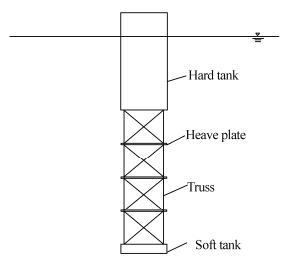
|
| Fig. 1 Simplified model of a truss spar platform |
We considered 1st-order and 2nd-order random wave loads as well as the effects of time-varying displacement volume and transient wave elevation to establish the motion equations of the spar platform’s coupled heave-pitch(Zhang, 2008; Tang et al., 2008)as follows:
| $$\begin{array}{l} ({M_{33}} + {A_{33}}){{\ddot \xi }_3} + {B_{33}}{{\dot \xi }_3} + {D_{33}}\left| {{{\dot \xi }_3}} \right|{{\dot \xi }_3} + \\ \rho g{A_w}\left( {{\xi _3} - \eta - \frac{1}{2}{H_g}\xi _5^2} \right) = F_{W3}^{(1)} + F_{W3}^{(2)} \end{array}$$ | (1) |
| $$\begin{array}{l} ({M_{55}} + {A_{55}}){{\ddot \xi }_5} + {B_{55}}{{\dot \xi }_5} + {D_{55}}\left| {{{\dot \xi }_5}} \right|{{\dot \xi }_5} + \\ \rho g\nabla \overline {{\rm{GM}}} {\xi _5} - \frac{1}{2}\rho g\left( {\nabla + 2{A_w} \times \overline {{\rm{GM}}} } \right){\xi _3}{\xi _5} + \\ \frac{1}{2}\rho g\left( {\nabla + 2{A_w} \times \overline {{\rm{GM}}} } \right)\eta {\xi _5} = F_{W5}^{(1)} + F_{W5}^{(2)} \end{array}$$ | (2) |
where ${\xi _3}$, ${\xi _5}$ are the heave displacement and pitch angular displacement of the platform, respectively. M33 and M55 represent the platform’s mass and pitch moment of inertia, respectively. ${A_{33}}$ and ${A_{55}}$ denote the added mass in the heave mode and the added moment of inertia in the pitch mode, respectively. B33 and B55 denote the linear damping coefficient in the heave and pitch modes, respectively. D33 and D55 denote the quadratic damping coefficient in the heave and pitch modes, respectively. $F_{W3}^{(1)}$ and $F_{W5}^{(1)}$ are 1st-order random wave loads in the heave and pitch modes, respectively. $F_{W3}^{(2)}$ and $F_{W5}^{(2)}$ are the 2nd-order random wave loads in the heave and pitch modes, respectively. Aw is the hull’s waterline area, η is wave elevation, Hg is the distance between the platform’s center of gravity and the static water surface, △ is displacement volume, and $\overline {{\rm{GM}}} $ is longitudinal metacentric height.
Eqs.(1)and(2)can be written in the following form:
| $${\ddot \xi _3} + {a_{11}}{\dot \xi _3} + {a_{12}}\left| {{{\dot \xi }_3}} \right|{\dot \xi _3} + {a_2}{\xi _3} - {a_2}\eta - {a_3}\xi _5^2 = {f_3}$$ | (3) |
| $${\ddot \xi _5} + {b_{11}}{\dot \xi _5} + {b_{12}}\left| {{{\dot \xi }_5}} \right|{\dot \xi _5} + {b_2}{\xi _5} - {b_3}{\xi _3}{\xi _5} + {b_3}\eta {\xi _5} = {f_5}$$ | (4) |
where ${a_{11}} = \frac{{{B_{33}}}}{{({M_{33}} + {A_{33}})}}$, ${a_{12}} = \frac{{{D_{33}}}}{{({M_{33}} + {A_{33}})}}$, ${a_2} = \frac{{\rho g{A_w}}}{{({M_{33}} + {A_{33}})}}$, ${a_3} = \frac{{\rho g{A_w}{H_g}}}{{2({M_{33}} + {A_{33}})}}$, ${f_3} = \frac{{F_{W3}^{(1)} + F_{W3}^{(2)}}}{{({M_{33}} + {A_{33}})}}$; ${b_{11}} = \frac{{{B_{55}}}}{{({M_{55}} + {A_{55}})}}$, ${b_{12}} = \frac{{{D_{55}}}}{{({M_{55}} + {A_{55}})}}$, ${b_2} = \frac{{\rho g\nabla \overline {{\rm{GM}}} }}{{({M_{55}} + {A_{55}})}}$, ${b_3} = \frac{1}{2}\frac{{\rho g\left( {\nabla + 2{A_w} \times \overline {{\rm{GM}}} } \right)}}{{({M_{55}} + {A_{55}})}}$, ${f_5} = \frac{{F_{W5}^{(1)} + F_{W5}^{(2)}}}{{({M_{55}} + {A_{55}})}}$.
2.2 Numerical simulation of random wavesAccording to the Longuet-Higgins random-wave model, a sea wave can be regarded as a stationary random process. The random-wave surface elevation, $\eta (t)$, can be represented as the sum of a series of regular wave components in the following form(Yu et al., 2011):
| $$\eta (t) = \sum\limits_{i = 1}^N {{a_i}} \cos ({k_i}x - {\omega _i}t + {\varepsilon _i})$$ | (5) |
where ai, ki, ${\omega _i}$ and ${\varepsilon _i}$ are the amplitude, wave number, circular frequency, and initial phase angle of the ith wave component, respectively. ${\varepsilon _i}$ is uniformly distributed in the range of (0, 2π). x and t denote position and time, respectively. The position is usually fixed and, here, x is assumed to be zero.
In this study, we simulate the random wave surface elevation through the frequency spectrum. We assume that the target wave spectrum to be simulated is S(ω) and that the wave energy is mainly distributed in the frequency range ωL-ωH, where the maximum frequency, ωH, is three or four times the spectrum’s peak frequency. We adopt the “equal frequency interval” method to divide the frequency range into a number of intervals. The length of each interval is △ω=(ωH-ωL)/N, where N is the number of wave components. To avoid repetition, we randomly select a circular wave frequency, ${\tilde \omega _i}$, within each interval. Considering the amplitude of the ith wave component, ${a_i} = \sqrt {2S({{\hat \omega }_i})\Delta {\omega _i}} $, where ${\hat \omega _i} = ({\omega _{i - 1}} + {\omega _i})/2$, the wave elevation can be written as follows:
| $$\eta (t) = \sum\limits_{i = 1}^N {\sqrt {2S({{\hat \omega }_i})\Delta {\omega _i}} } \cos ({\tilde \omega _i}t + {\varepsilon _i})$$ | (6) |
Expressed in its complex form, Eq.(6)then changes to the following:
| $$\left\{ \begin{array}{l} \eta (t) = {\mathop{\rm Re}\nolimits} \sum\limits_{i = 1}^N {{A_i}{{\rm{e}}^{{\rm{j}}{{\tilde \omega }_i}t}}} \\ {A_i} = {a_i}{{\rm{e}}^{{\rm{j}}{\varepsilon _i}}} \end{array} \right.$$ | (7) |
where Ai is the ith complex-valued wave component amplitude(including phase).
Herein, we select the JONSWAP wave spectrum to simulate random waves so the function of the wave spectrum is represented as follows:
| $$S(\omega ) = \frac{{\alpha {g^2}}}{{{\omega ^5}}}\exp \left[ { - \frac{5}{4}{{\left( {\frac{{{\omega _p}}}{\omega }} \right)}^4}} \right]{\gamma ^{\exp \left[ { - \frac{{{{\left( {\omega - {\omega _p}} \right)}^2}}}{{2{\sigma ^2}\omega _p^2}}} \right]}}$$ | (8) |
where α is the energy scale parameter, $\alpha = {\left( {\frac{{{H_S}\omega _p^2}}{{4g}}} \right)^2}\frac{1}{{0.065{\gamma ^{0.803}} + 0.135}}$, HS is the significant wave height, γ is the peakedness parameter, ωp is peak frequency, ${\omega _p} = 2\pi {\rm{/}}2\pi {T_p}$, and Tp is peak period. σ is the spectral parameter with the default values as follows: σ=0.07, for $\omega < {\omega _p}$; σ = 0.09, for $\omega > {\omega _p}$.
2.3 Numerical simulation of random wave loadsThe truss spar platform is mainly subjected to wave loads on the hull, and since the wave loads on the heave plates are relatively small, they can be omitted. Herein, we consider the heave plates by adding their mass and viscous damping effects. To obtain the random wave loads in the time domain, we first compute the wave load transfer functions by frequency-domain hydrodynamic analysis. Then based on the wave spectrum, we generate a random-wave-load time series in the time domain.
1st-order random wave load can be expressed as follows:
| $$F_{ex}^{(1)}(t) = {\mathop{\rm Re}\nolimits} \left\{ {\sum\limits_{n = 1}^N {{A_n}{H^{(1)}}({\omega _n}){{\rm{e}}^{{\rm{j}}{\omega _n}t}}} } \right\}$$ | (9) |
where ${H^{(1)}}({\omega _n})$ is the linear transfer function in the frequency domain.
The 2nd-order random wave load can be represented as follows(Newman, 1974):
| $$F_{ex}^{(2)}(t) = {\mathop{\rm Re}\nolimits} \left\{ {\sum\limits_{n = 1}^N {\sum\limits_{m = 1}^N {\left[ \begin{array}{l} {A_n}{A_m}{H^{(2 + )}}({\omega _n},{\omega _m}){{\rm{e}}^{{\rm{j}}({\omega _n} + {\omega _m})t}}\\ + {A_n}A_m^*{H^{(2 - )}}({\omega _n},{\omega _m}){{\rm{e}}^{{\rm{j}}({\omega _n} - {\omega _m})t}} \end{array} \right]} } } \right\}$$ | (10) |
where $A_m^*$ is the conjugate of the complex wave amplitude ${A_m}$, ${H^{(2 + )}}({\omega _n},{\omega _m})$ is the quadratic transfer function(QTF)for the 2nd-order sum-frequency wave load, and ${H^{(2 - )}}({\omega _n},{\omega _m})$ is the QTF for the 2nd-order difference- frequency wave load.
Since the spar platform’s natural heave and pitch frequencies are usually lower than the wave frequency, the sum-frequency wave load can be neglected. Thus, we consider only the difference-frequency wave load. Then the 2nd-order random wave load changes to the following:
| $$F_{ex}^{(2 - )}(t) = {\mathop{\rm Re}\nolimits} \left\{ {\sum\limits_{n = 1}^N {\sum\limits_{m = 1}^N {\left[ {{A_n}A_m^*{H^{(2 - )}}({\omega _n},{\omega _m}){{\rm{e}}^{{\rm{j}}({\omega _n} - {\omega _m})t}}} \right]} } } \right\}$$ | (11) |
The double summation appearing in Eq.(11)can be divided into three regions, namely n=m, n>m, and n<m. Letting μ=n-m results(Langley, 1986)in the following:
| $$\begin{array}{l} F_{ex}^{(2 - )}(t) = {\mathop{\rm Re}\nolimits} \{ \sum\limits_{n = 1}^N {{A_n}A_n^*{H^{(2 - )}}({\omega _n},{\omega _n})} + \\ \sum\limits_{\mu = 1}^{N - 1} {\sum\limits_{m = 1}^{N - \mu } {\left[ {{A_{m + \mu }}A_m^*{H^{(2 - )}}({\omega _{m + \mu }},{\omega _m}){{\rm{e}}^{{\rm{j}}{\omega _\mu }t}}} \right]} } + \\ \sum\limits_{\mu = 1}^{N - 1} {\sum\limits_{m = 1}^{N - \mu } {\left[ {{A_m}A_{m + \mu }^*{H^{(2 - )}}({\omega _m},{\omega _{m + \mu }}){{\rm{e}}^{ - {\rm{j}}{\omega _\mu }t}}} \right]} } \} \end{array}$$ | (12) |
Considering the symmetry relation for the difference- frequency QTF matrices as follows:
| $${H^{(2 - )}}({\omega _n},{\omega _m}) = {H^{(2 - )}}({\omega _m},{\omega _n})*$$ | (13) |
The 2nd-order difference-frequency random wave load can be expressed as follows:
| $$F_{ex}^{(2 - )}(t) = {\mathop{\rm Re}\nolimits} \left\{ {\sum\limits_{n = 1}^N {{A_n}A_n^*{H^{(2 - )}}({\omega _n},{\omega _n})} + 2\sum\limits_{\mu = 1}^{N - 1} {{X_\mu }{{\rm{e}}^{{\rm{j}}{\omega _\mu }t}}} } \right\}$$ | (14) |
where
| $${X_\mu } = \sum\limits_{m = 1}^{N - \mu } {{A_{m + \mu }}A_m^*{H^{(2 - )}}({\omega _{m + \mu }},{\omega _m})} ,{\rm{ }}\mu = 1,{\rm{ }}2, \cdots ,{\rm{ }}N - 1$$ | (15) |
In Eq.(14), the first term denotes the 2nd-order mean wave load and the second term represents the 2nd-order slowly varying wave load.
We can compute the wave-load transfer functions ${H^{(1)}}({\omega _n})$ and ${H^{(2 - )}}({\omega _n},{\omega _m})$ through a frequency-domain hydrodynamic analysis. We then wrote a customized program code to generate the 1st-order and 2nd-order random wave loads using Eqs.(9)-(15). We also designed another program code to solve the coupled motion equations with the generated random-wave loads at each time step and thereby obtained the time-domain motion responses.
3 Results and analysisThe main parameters of the truss spar platform are given in Table 1. The 1st-order motion RAOs of the spar platform are shown in Fig. 2.
| Items | Value |
| Total length/m | 169.16 |
| Draft/m | 153.92 |
| Displacement/t | 56 401.45 |
| Length of hard tank/m | 68.88 |
| Draft of hard tank/m | 53.64 |
| Diameter of hard tank/m | 32.31 |
| Size of heave plates/m2 | 32.31×32.31 |
| Spacing of heave plates/m | 23.77 |
| Gyradius of pitch/m | 60.96 |
| Center of gravity from keel(KG)/m | 90.39 |
| Center of buoyance from keel(KB)/m | 107.69 |
| Heave natural period/s | 24.40 |
| Pitch natural period/s | 39.10 |
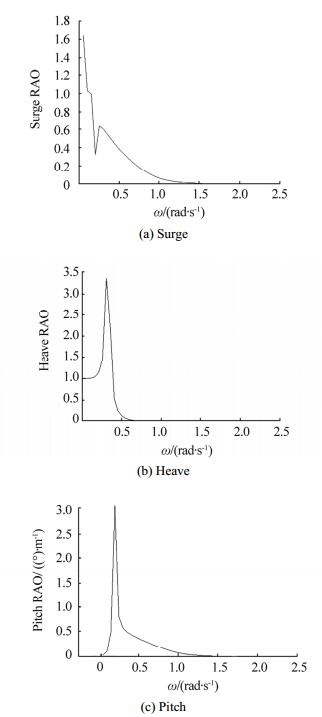
|
| Fig. 2 1st-order motion RAOs |
Based on the methods introduced in the previous section, we can simulate the coupled heave-pitch motion responses in the time domain. We set the simulation length to be 3 h and the time step to be 0.5 s, and select the damping coefficients in the motion equations based on the model test results. Since the linear damping is small and can be ignored, we consider only viscous damping here. The parameters used in the simulation are as follows: a12=0.079 7, b12= 0.069 6(Liu et al., 2014).
3.1 Comparison of motion responses in different sea conditionsTo investigate the platform’s motion response characteristics in different sea conditions, we selected four wave environment conditions as computation cases from those listed in Table 2(Li and Ou, 2009)and plotted the spectral density functions, as shown in Fig. 3.
| Items | Significant wave height HS/m | Peak period Tp/s |
| A. GoM extreme condition | 12.20 | 14.0 |
| B. GoM working condition | 3.96 | 9.0 |
| C. West Africa swell | 4.70 | 22.0 |
| D. South China Sea(typhoon) | 13.60 | 15.1 |

|
| Fig. 3 Wave spectrum densities of four sea conditions |
The average, standard deviation, maximum, and minimum values of the responses for different sea conditions are shown in Table 3 and plotted in Fig. 4.
| Items | Heave/m | Pitch/rad | ||||||
| Avg. | Stdev. | Max. | Min. | Avg. | Stdev. | Max. | Min. | |
| A | 0.741 | 2.110 | 8.301 | −4.970 | 0 | 0.134 | 0.430 | −0.387 |
| B | 0.007 | 0.161 | 0.635 | −0.664 | 0.001 | 0.013 | 0.030 | −0.032 |
| C | 0.505 | 3.184 | 8.362 | −8.071 | 0 | 0.116 | 0.350 | −0.399 |
| D | 1.275 | 2.945 | 11.704 | −7.184 | 0.002 | 0.168 | 0.565 | −0.524 |
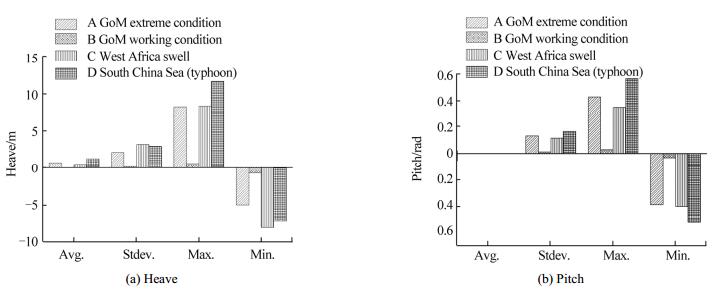
|
| Fig. 4 Comparison of the spar platform’s motion responses under different sea conditions |
Based on the results shown in Table 3 and Fig. 4, we draw the following conclusions:
1)The spar platform’s heave-pitch coupling motion responses in different sea areas are primarily dominated by two wave parameters, i.e., significant wave height and peak period.
2)As shown in Table 2, the significant wave heights of sea conditions C and B are similar, while the peak periods of these two conditions differ greatly. As a result, the response in condition C is much greater than that in condition B, which shows that the peak period of the wave spectrum has a great influence on the platform’s motion responses.
3)Because of the effect of 2nd-order mean wave loads, the average heave response is no longer zero. In other words, there is a deviation from the equilibrium position in the heave direction. 2nd-order mean wave loads have no obvious effect on the average pitch response.
3.2 Effect of 2nd-order random wave loadsNext, we investigate the effect of 2nd-order random wave loads. Considering the effect of 1st-order wave loads, we compute the spar platform’s heave-pitch coupling motion responses for conditions A and B and then compare the results with those under the effect of both 1st-order and 2nd-order wave loads. Time series of the responses are shown in Figs. 5 and 6. We obtained the response power spectra by performing a fast Fourier transform on the time series, as shown in Figs. 7 and 8.

|
| Fig. 5 Heave-pitch coupled motion responses under GoM extreme conditions |

|
| Fig. 6 Heave-pitch coupled motion responses under GoM working conditions |

|
| Fig. 7 Power spectrum of motion responses under GoM extreme conditions |
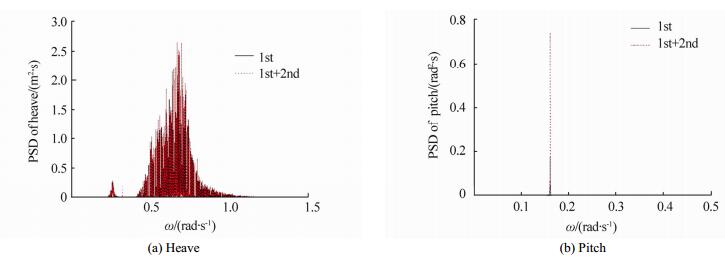
|
| Fig. 8 Power spectrum of motion responses under GoM working conditions |
In Figs. 5 and 6, the solid lines represent the platform’s motion responses under the effect of 1st-order wave loads, while the dashed lines represent the responses under the effect of both 1st-order and 2nd-order wave loads. From Figs. 5(a) and 6(a), we can see that the platform’s heave response amplitudes in conditions A and B change very little after considering the 2nd-order wave loads. However, as shown in Figs. 5(b) and 6(b), 2nd-order wave loads have a great influence on the platform’s pitch. The pitch amplitudes in conditions A and B increase significantly after including the effect of 2nd-order wave loads.
In Figs. 7 and 8, the solid lines represent the platform’s response power spectra under the effect of 1st-order wave loads, while the dashed lines representthe response power spectra under the effect of both 1st-order and 2nd-order wave loads. When considering only the effect of 1st-order wave loads, as shown in Figs. 7(a) and 8(a), the energy of the platform’s heave response is mainly concentrated in the vicinity of the wave frequency. In Figs. 7(b) and 8(b), the energy of the pitch response is mainly concentrated at the natural frequency of the pitch mode. This can be interpreted by analyzing the relationship between the platform’s natural period and the wave peak period, with reference to Tables 1 and 2. The natural heave period is closer to the wave peak period. Thus, the wave-frequency motion response is dominant for heave. In contrast, the natural pitch period is not at all similar to the peak period. Thus, the effect of wave-frequency load is quite small and motion near the natural period is dominant for pitch.
After considering the effect of 2nd-order wave loads, we can see from Figs. 7(b) and 8(b) that the peak values of the pitch response power spectra increase greatly, while from Figs. 7(a) and 8(a), we see that the effect of the 2nd-order wave loads on the heave response power spectra is not significant. In fact, the frequency of the 2nd-order wave load is closer to the natural pitch frequency, thus causing resonance in the pitch mode. As a result, there is a large amplitude increase in the platform’s pitch response.
3.3 Effect of transient wave elevationTo study the effect of transient wave elevation on the platform’s motion, we omitted the wave elevation term η. The motion equations can then be written as follows:
| $$\begin{array}{l} ({M_{33}} + {A_{33}}){{\ddot \xi }_3} + {B_{33}}{{\dot \xi }_3} + {D_{33}}\left| {{{\dot \xi }_3}} \right|{{\dot \xi }_3} + \\ \rho g{A_w}\left( {{\xi _3} - \frac{1}{2}{H_g}\xi _5^2} \right) = F_{W3}^{(1)} + F_{W3}^{(2)} \end{array}$$ | (16) |
| $$\begin{array}{l} ({M_{55}} + {A_{55}}){{\ddot \xi }_5} + {B_{55}}{{\dot \xi }_5} + {D_{55}}\left| {{{\dot \xi }_5}} \right|{{\dot \xi }_5} + \rho g\nabla \overline {GM} {\rm{ }}{\xi _5} - \\ \frac{1}{2}\rho g\left( {\nabla + 2{A_w} \times \overline {GM} } \right){\xi _3}{\xi _5} = F_{W5}^{(1)} + F_{W5}^{(2)} \end{array}$$ | (17) |
Next, we computed the platform’s heave-pitch coupling responses without considering transient wave elevation for conditions A and B, and the statistical results are listed in Table 4. We then plotted the response time series in Figs. 9 and 10, and compared these with the results that considered wave elevation. In Figs. 9 and 10, the solid lines represent the platform’s response, while considering the effect of transient wave elevation η, and the dashed lines represent the response without considering η.
| Items | Heave/m | Pitch/rad | ||||||
| Avg. | Stdev. | Max. | Min. | Avg. | Stdev. | Max. | Min. | |
| A GoM extreme condition | 0.679 | 1.073 | 5.298 | −2.262 | 0.004 | 0.127 | 0.371 | −0.368 |
| B GoM working condition | 0.006 | 0.024 | 0.083 | −0.072 | 0.001 | 0.013 | 0.028 | −0.031 |
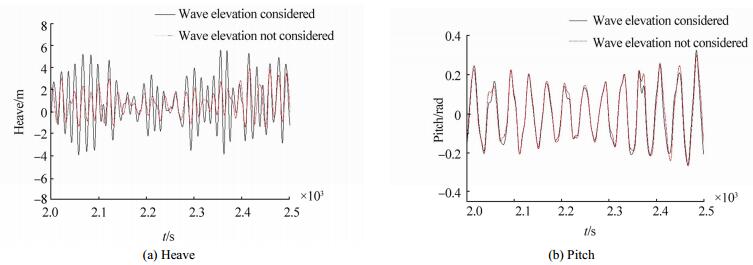
|
| Fig. 9 Comparison of the spar platform’s responses with/without transient wave elevation(GoM extreme conditions) |
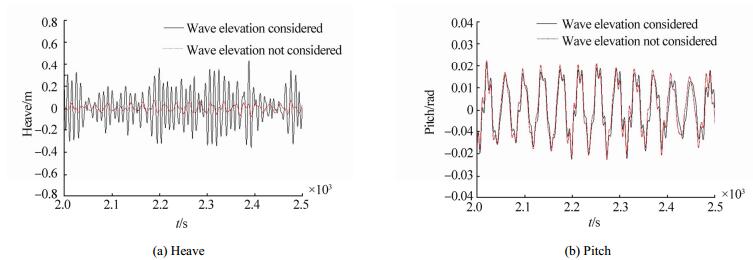
|
| Fig. 10 Comparison of the spar platform’s responses with/without transient wave elevation(GoM working conditions) |
Based on the results shown in Tables 3 and 4, and in Figs. 9 and 10, we draw the following conclusions:
1)Transient wave elevation η mainly affects the platform’s heave. The heave amplitude increases significantly when considering the effect of η.
2)The effect of η on the pitch response is not significant. The pitch amplitude changes very little when considering η.
After further analysis, we know that the transient wave elevation directly affects the platform’s restoring force and moment. The influence of η on the heave restoring force is greater than that on the pitch restoring moment. Thus, the platform’s pitch is not sensitive to η; however, the platform’s heave will be underestimated without considering the effect of η. So, it is essential to include the effect of transient wave elevation when performing a heave-motion analysis for a spar platform.
4 ConclusionsBy considering 1st-order and 2nd-order random wave loads, as well as the effects of the time-varying displacement volume and transient wave elevation, we established motion equations for the spar platform’s coupled heave-pitch. We generated random wave loads based on the frequency-domain wave load transfer functions and JONSWAP wave spectrum, and then computed and compared motion responses for different sea conditions. We also investigated the effects of 2nd-order random wave loads and transient wave elevation. Our main conclusions are as follows:
1)The coupled heave-pitch coupling motion responses of a spar platform in different sea conditions are primarily dominated by two wave parameters, i.e., significant wave height and peak period. Of these two parameters, the latter has a greater influence on the platform’s motion responses.
2)The 2nd-order mean wave load mainly affects the average heave response, while it has no obvious effect on the average pitch response.
3)1st-order wave loads mainly induce the platform’s wave frequency heave, while the pitch in the wave frequency is quite small. The 2nd-order low-frequency wave load mainly affects the platform’s pitch, while having little effect on the platform’s heave.
4)While the effect of transient wave elevation on pitch is small, it has a significant influence on the platform’s heave. Therefore, it is essential that the effect of transient wave elevation be considered when performing a heave-motion analysis for a spar platform.
| Dong Yanqiu, 2005. Wave loads and response of the oil-extraction platform in deep ocean. Tianjin University Press, Tianjin, China, 94-102. (in Chinese) |
| Gavassoni E, Gonçalves PB, Roehl DM, 2014. Nonlinear vibration modes and instability of a conceptual model of a spar platform. Nonlinear Dynamics, 76(1), 809-826. DOI: 10.1007/s11071-013-1171-6 |
| Hong YP, Lee DY, Choi YH, Hong SK, Kim SE, 2005. An experimental study on the extreme motion responses of a spar platform in the heave resonant waves. The Fifteenth International Offshore and Polar Engineering Conference, Seoul, Korea, 225-232. |
| Islam AS, Jameel M, Ahmad S, Jumaat MZ, 2012. Nonlinear response of coupled integrated spar platform under severe sea states. The 31st International Conference on Ocean, Offshore and Arctic Engineering, Rio de Janeiro, Brazil, 559-567. DOI: 10.1115/OMAE2012-83862 |
| Jameel M, Ahmad S, Islam AS, Jumaat MZ, 2014. Wind induced nonlinear response of coupled spar platform. The 33rd International Conference on Ocean, Offshore and Arctic Engineering. San Francisco, USA, V08AT06A061. DOI: 10.1115/OMAE2014-23779 |
| Kurian VJ, Montasir OA, Narayanan SP, 2009. Numerical and model test results for truss spar platform. The Nineteenth International Offshore and Polar Engineering Conference, Osaka, Japan, 99-104. |
| Kurian VJ, Ng CY, Liew MS, 2013. Effect of short-crested waves on the dynamic responses of truss spar platforms. The Twenty-Third International Offshore and Polar Engineering Conference, Anchorage, USA, 899-906. |
| Langley RS, 1986. On the time domain simulation of second order wave forces and induced responses. Applied Ocean Research, 8(3), 134-143. DOI: 10.1016/S0141-1187(86)80012-8 |
| Li Binbin, Ou Jinping, 2009. Heave response analysis of truss spar in frequency domain. The Ocean Engineering, 27(1), 8-15. (in Chinese) |
| DOI:10.3969/j.issn.1005-9865.2009.01.002 |
| Liu Liqin, Incecik A, Zhang Yongheng, Tang Yougang, 2014. Analysis of heave motions of a truss spar platform with semi-closed moon pool. Ocean Engineering, 92, 162-174. |
| DOI:10.1016/j.oceaneng.2014.09.048 |
| Liu Liqin, Tang Yougang, Wang Wenjie, 2009. Unstability of coupled heave-pitch motions for spar platform. Journal of Ship Mechanics, 13(4), 551-556. (in Chinese)DOI: 10.3969/j.issn.1007-7294.2009.04.006 |
| Liu Liqin, Zhou Han, Tang Yougang, 2015. Coupling response of heave and moonpool water motion of a truss spar platform in random waves. China Ocean Engineering, 29(2), 169-182. DOI: 10.1007/s13344-015-0013-3 |
| Montasir OA, Kurian VJ, 2011. Effect of slowly varying drift forces on the motion characteristics of truss spar platforms. Ocean Engineering, 38, 1417-1429. DOI: 10.1016/j.oceaneng.2011.07.007 |
| Montasir OA, Yenduri A, Kurian VJ, 2015. Effect of mooring line configurations on the dynamic responses of truss spar platforms. Ocean Engineering, 96, 161-172. DOI: 10.1016/j.oceaneng.2014.11.027 |
| Neves MA, Sphaier SH, Mattoso BM, Rodriíguez CA, Santos AL, Vileti VL, Torres FG, 2008. On the occurrence of Mathieu instabilities of vertical cylinders. The 27th International Conference on Offshore Mechanics and Arctic Engineering, Estoril, Portugal, 619-627. DOI: 10.1115/OMAE2008-57567 |
| Newman JN, 1974. Second-order, slowly-varying forces on vessels in irregular waves. International Symposium on the Dynamics of Marine Vehicles and Structures in Waves, London, 182-186. |
| Rho JB, Choi HS, 2004. Vertical motion characteristics of truss spars in waves. The Fourteenth International Offshore and Polar Engineering Conference, Toulon, France, 662-665. |
| Rho JB, Choi HS, Lee WC, Shin HS, Park IK, 2002. Heave and pitch motions of a spar platform with damping plate. The Twelfth International Offshore and Polar Engineering Conference, Kitakyushu, Japan, 198-201. |
| Rho JB, Choi HS, Shin HS, Park IK, 2003. An experimental study for mooring effects on the stability of spar platform. The Thirteenth International Offshore and Polar Engineering Conference, Honolulu, USA, 285-288. |
| Rodriguez CA, Neves MA, 2012. Nonlinear instabilities of spar platforms in waves. The 31st International Conference on Ocean, Offshore and Arctic Engineering, Rio de Janeiro, Brazil, 605-614. DOI: 10.1115/OMAE2012-83577 |
| Sang Song, Li Changdong, Xu Xuejun, Shi Xiao, 2014. Study on stability of spar platform in deep sea under combination resonance excitation. Journal of Ship Mechanics, 18(10), 1195-1203. (in Chinese) DOI: 10.3969/j.issn.1007-7294.2014.10.005 |
| Shen Wenjun, Tang Yougang, 2011. Stochastic analysis of nonlinear coupled heave-pitch motion for the truss spar platform. Journal of Marine Science and Application, 10(4), 471-477. DOI: 10.1007/s11804-011-1093-y |
| Shen Wenjun, Tang Yougang, Li Hongxia, 2012. Time domain analysis of heave motion for truss spar in random seas. The Ocean Engineering, 30(1), 60-65. (in Chinese) DOI: 10.3969/j.issn.1005-9865.2012.01.009 |
| Tang Yougang, Shen Guoguang, Liu Liqin, 2008. Structural dynamics of ocean engineering. Tianjin University Press, Tianjin, China, 284-288. (in Chinese) |
| Tao LB, Lim KY, Thiagarajan K, 2004. Heave response of classic spar with variable geometry. Journal of Offshore Mechanics and Arctic Engineering, 126(1), 90-95. DOI: 10.1115/1.1643085 |
| Wang Bin, Liu Liqin, Tang Yougang, 2014. CFD simulation of the vertical motion characteristics of the moonpool fluid for the truss spar. Journal of Marine Science and Application, 13(1), 92-98.DOI: 10.1007/s11804-014-1232-3 |
| Yang Hezhen, Xu Peiji, 2015. Effect of hull geometry on parametric resonances of spar in irregular waves. Ocean Engineering, 99, 14-22. DOI: 10.1016/j.oceaneng.2015.03.006 |
| Yu Yuxiu, Liu Shuxue, 2011. Random wave and its application for engineering. Dalian University of Technology Press, Dalian, China, 221-230. (in Chinese) |
| Zhang Haiyan, 2008. Study on nonlinear motion behavior of coupled heave-pitch for the spar platform. PhD thesis, Tianjin University, Tianjin, 19-28. (in Chinese) |
| Zhao Jingrui, Tang Lizhi, Tang Yougang, Wang Wenjie, 2009. Internal resonant responses of heave-pitch coupled motions of classic spar platform. Journal of Tianjin University, 42(3), 201-207. (in Chinese) DOI: 10.3969/j.issn.0493-2137.2009.03.003 |



